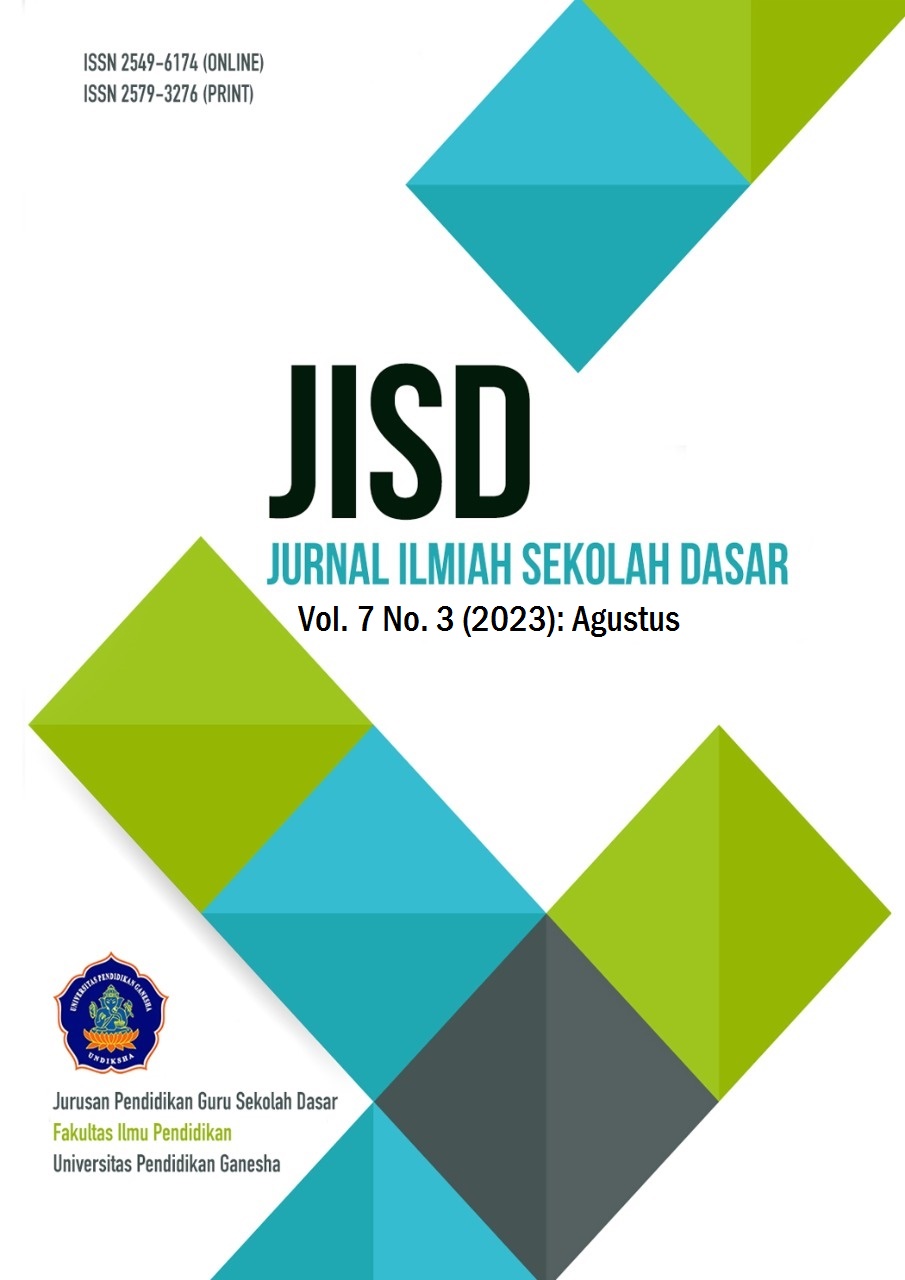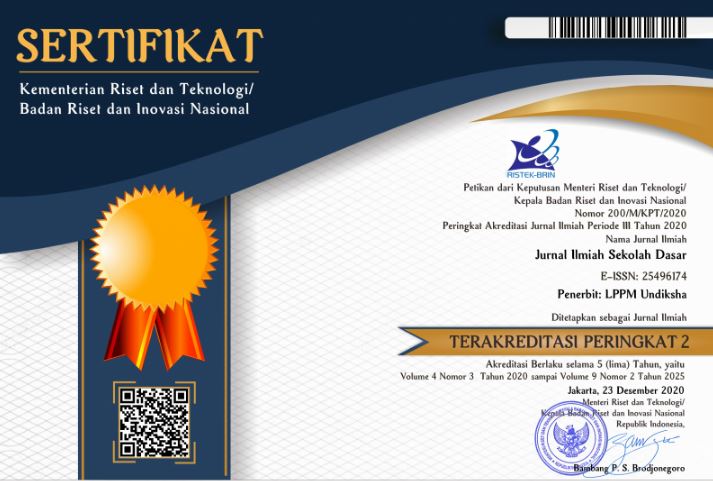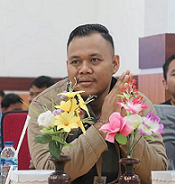Integrated STEM-based Teaching Modules with the Values of Pancasila Student Profiles in Supporting the Implementation of Kurikulum Merdeka in Primary School
DOI:
https://doi.org/10.23887/jisd.v7i3.57198Keywords:
STEM Teaching Module, Profile of Pancasila Students, Elementary School StudentsAbstract
The presence of the Merdeka Curriculum as a new curriculum in Indonesia requires teachers to be able to adapt to these changes. On the other hand, there still needs to be more teacher references in implementing meaningful and character learning as aspired to through this new curriculum. Therefore, this development research aims to develop STEM-based teaching modules for 4th-grade elementary schools integrated with the Pancasila Student Profile. This type of research is developed using the ADDIE development model (Analyse, Design, Development, Implement, Evaluate). This research involved teachers and 50 grade 4 students in one of the public elementary schools in Indonesia. The modules were developed based on the needs of teachers and students obtained through observation, interviews, and diagnostic tests on students. Data analysis techniques using qualitative and quantitative descriptive analysis. The study's results, namely the validation of the experts on the module, showed a very good category for the material, display, and graphic aspects. The developed module is considered very practical for teachers in the classroom, while the student response to learning using the module is very good. It has a direct impact on student learning outcomes which are very satisfying. Thus, the developed module is feasible and can be an alternative reference for teachers in carrying out STEM-based learning by integrating the values of the Pancasila Student Profile.
References
Aeni, A. N. (2019). Persepsi Guru SD Dan Mahasiswa Calon Guru SD Tentang Kualitas Pendidikan di Indonesia. Metodik Didaktik : Jurnal Pendidikan Ke-SD-An, 15(1), 21–31. https://doi.org/https://doi.org/10.17509/md.v15i1.
Al-Balushi, S. M., & Al-Aamri, S. S. (2014). The effect of environmental science projects on students environmental knowledge and science attitudes. International Research in Geographical and Environmental Education, 23(3), 213–227. https://doi.org/10.1080/10382046.2014.927167. DOI: https://doi.org/10.1080/10382046.2014.927167
Amri, S., Haryanto, D., & Ahmadi, I. K. (2010). Proses pembelajaran inovatif dan kreatif dalam kelas : Metode, landasan teoritis-praktis dan penerapannya. Prestasi Pustaka Publisher.
Amsar, R. M., Barlian, A., Judawisastra, H., Wibowo, U. A., & Karina, K. (2021). Cell penetration and chondrogenic differentiation of human adipose derived stem cells on 3D scaffold. Future Science OA, 7(8). https://doi.org/10.2144/fsoa-2021-0040. DOI: https://doi.org/10.2144/fsoa-2021-0040
Bansilal, S. (2010). How much freedom does a teacher have in designing a learning event when adhering to assessment prescription? Education as Change, 14(1), 77–90. https://doi.org/10.1080/16823206.2010.494339. DOI: https://doi.org/10.1080/16823206.2010.494339
Barak, M. (2012). From “doing” to “doing with learning”: reflection on an effort to promote self-regulated learning in technological projects in high school. European Journal of Engineering Education, 37(1), 105–116. https://doi.org/10.1080/03043797.2012.658759. DOI: https://doi.org/10.1080/03043797.2012.658759
Barrett, B. S., Moran, A. L., & Woods, J. E. (2014). Meteorology meets engineering: an interdisciplinary STEM module for middle and early secondary school students. International Journal of STEM Education, 1(1), 1–7. https://doi.org/10.1186/2196-7822-1-6. DOI: https://doi.org/10.1186/2196-7822-1-6
Bell, S. (2010). Project-Based Learning for the 21st Century: Skills for the Future. The Clearing House: A Journal of Educational Strategies, Issues and Ideas, 83(2), 39–43. https://doi.org/10.1080/00098650903505415. DOI: https://doi.org/10.1080/00098650903505415
Blanchard, M. R., Southerland, S. A., & Granger, E. M. (2009). No silver bullet for inquiry: Making sense of teacher change following an inquiry-based research experience for teachers. Science Education, 93(2), 322–360. https://doi.org/10.1002/sce.20298. DOI: https://doi.org/10.1002/sce.20298
Daniels, D. C. (2002). Becoming a Reflective Practitioner. Middle School Journal, 33(5), 52–56. https://doi.org/10.1080/00940771.2002.11495332. DOI: https://doi.org/10.1080/00940771.2002.11495332
Dekawati, I. (2020). The Principal’s Leadership as the Effort To Build Students’ Character. International Journal of Educational Management and Innovation, 1(2), 109. https://doi.org/10.12928/ijemi.v1i2.1631. DOI: https://doi.org/10.12928/ijemi.v1i2.1631
Farihah, M. J., Norawi, A. M., & Jahan, A. N. (2021). Game-Based STEM Module Development for KSSM Science Teachers. Journal of Turkish Science Education, 18(2), 249–262. https://doi.org/10.36681/tused.2021.63. DOI: https://doi.org/10.36681/tused.2021.63
Fearnley, M. R., & Amora, J. T. (2020). Learning Management System Adoption in Higher Education Using the Extended Technology Acceptance Model. IAFOR Journal of Education, 8(2), 89–106. https://doi.org/10.22492/ije.8.2.05. DOI: https://doi.org/10.22492/ije.8.2.05
Haidar, R. A., & Agustina, F. (2021). Analisis Teori Kritis terhadap Wajah Pendidikan Indonesia Pada Era Pandemi Covid-19. Jurnal Sentris, 2(2), 121–131. https://doi.org/10.26593/sentris.v2i2.5081.121-131. DOI: https://doi.org/10.26593/sentris.v2i2.5081.121-131
Kaldi, S., Filippatou, D., & Govaris, C. (2011). Project-based learning in primary schools: Effects on pupils’ learning and attitudes. Education 3-13, 39(1), 35–47. https://doi.org/10.1080/03004270903179538. DOI: https://doi.org/10.1080/03004270903179538
Kokotsaki, D., Menzies, V., & Wiggins, A. (2016). Project-based learning: A review of the literature. Improving Schools, 19(3), 267–277. https://doi.org/10.1177/1365480216659733. DOI: https://doi.org/10.1177/1365480216659733
Kolar, V. M., & Hodnik, T. (2021). Mathematical literacy from the perspective of solving contextual problems. European Journal of Educational Research, 10(1), 467–483. https://doi.org/10.12973/EU-JER.10.1.467. DOI: https://doi.org/10.12973/eu-jer.10.1.467
Makaborang, Y. (2019). Evaluasi Implementasi Kurikulum 2013 Mata Pelajaran Biologi Di SMA Negeri. Kelola: Jurnal Manajemen Pendidikan, 6(2). https://doi.org/10.24246/j.jk.2019.v6.i2.p130-145. DOI: https://doi.org/10.24246/j.jk.2019.v6.i2.p130-145
Mardhiyah, R. H., Aldriani, S. N. F., Chitta, F., & Zulfikar, M. R. (2021). Pentingnya Keterampilan Belajar di Abad 21 sebagai Tuntutan dalam Pengembangan Sumber Daya Manusia. Lectura: Jurnal Pendidikan, 12(1), 29–40. https://doi.org/10.31849/lectura.v12i1.5813. DOI: https://doi.org/10.31849/lectura.v12i1.5813
Margolis, J., Meese, A. A., & Doring, A. (2016). Do Teachers Need Structure or Freedom to Effectively Teach Urban Students? A Review of the Educational Debate. Education and Urban Society, 48(9), 783–806. https://doi.org/10.1177/0013124516630791. DOI: https://doi.org/10.1177/0013124516630791
Mu’minah, I. H., & Aripin, I. (2019). Implementasi STEM dalam pembelajaran abad 21. Prosiding Seminar Nasional Pendidikan, 1, 1495–1503. https://mail.prosiding.unma.ac.id/index.php/semnasfkip/article/view/219.
Mudhofir, A., & Rusydiyah, E. F. (2017). Desain Pembelajaran Inovatif Dari Teori ke Praktik. Rajawali Press.
Nasir, N., Bagea, I., Sumarni, S., Herlina, B., & Safitri, A. (2020). Memaksimalkan Fitur “Breaking Rooms” Zoom Meeting pada Pendidikan Anak Usia Dini di Masa Pandemi Covid-19. Jurnal Obsesi : Jurnal Pendidikan Anak Usia Dini, 5(1). https://doi.org/10.31004/obsesi.v5i1.662. DOI: https://doi.org/10.31004/obsesi.v5i1.662
Papilaya, J. O., & Huliselan, N. (2016). Identifikasi Gaya Belajar Mahasiswa. Jurnal Psikologi Undip, 15(1), 56. https://doi.org/10.14710/jpu.15.1.56-63. DOI: https://doi.org/10.14710/jpu.15.1.56-63
Perdana, R., & Suswandari, M. (2021). Literasi Numerasi Dalam Pembelajaran Tematik Siswa Kelas Atas Sekolah Dasar. Absis: Mathematics Education Journal, 3(1), 9. https://doi.org/10.32585/absis.v3i1.1385. DOI: https://doi.org/10.32585/absis.v3i1.1385
Peters, E. E. (2010). Shifting to a student-centered science classroom: An exploration of teacher and student changes in perceptions and practices. Journal of Science Teacher Education, 21(3), 329–349. https://doi.org/10.1007/s10972-009-9178-z. DOI: https://doi.org/10.1007/s10972-009-9178-z
Prastowo, A. (2017). Urgensi Waktu Belajar dalam Pendidikan Karakter di SD/MI: Studi Analisis Isi terhadap Permendibud Nomor 23 Tahun 2017Urgensi Waktu Belajar dalam Pendidikan Karakter di SD/MI: Studi Analisis Isi Terhadap Permendikbud Nomor 23 Tahun 2017. Al Ibtida: Jurnal Pendidikan Guru MI, 4(2), 129. https://doi.org/10.24235/al.ibtida.snj.v4i2.1724. DOI: https://doi.org/10.24235/al.ibtida.snj.v4i2.1724
Pratikno, Y., Hermawan, E., & Arifin, A. L. (2022). Human Resource ‘Kurikulum Merdeka’ from Design to Implementation in the School: What Worked and What not in Indonesian Education. Jurnal Iqra’ : Kajian Ilmu Pendidikan, 7(1), 326–343. https://doi.org/https://doi.org/10.25217/ji.v7i1.1708. DOI: https://doi.org/10.25217/ji.v7i1.1708
Ramadita, Z. U., Abdurrahman, A., & Suyatna, A. (2021). Implementasi Kurikulum Terpadu Model Integrated Berbasis STEM menggunakan Flipped Classroom untuk Meningkatkan Penguasaan Konsep. Jurnal Ilmiah Pendidikan Fisika, 5(3). https://doi.org/10.20527/jipf.v5i3.3739. DOI: https://doi.org/10.20527/jipf.v5i3.3739
Roslan, M., Nor, M., & Malim, M. (2014). Revisiting Islamic education: the case of Indonesia. Journal for Multicultural Education, 8(4), 261–276. https://doi.org/10.1108/JME-05-2014-0019. DOI: https://doi.org/10.1108/JME-05-2014-0019
Saifudin, M. F., & Sukma, H. H. (2020). Pengembangan Media Audio Menyimak Tematik Berbasis Fitrah Bagi Siswa Sekolah Dasar. Jurnal Inovasi Pendidikan Dasar, 5(2), 59–70. https://doi.org/10.22236/jipd.v5i2.118. DOI: https://doi.org/10.22236/jipd.v5i2.118
Schiller, S. Z. (2002). Practicing Learner-Centered Teaching: Pedagogical Design and Assessment of a Second Life Project. Journal of Information Systems Education, 20(3), 369–382. http://jise.org/Volume20/n3/JISEv20n3p369.html.
Sherlyane Hendri, S., Hendri, S., Kiswanto Kenedi, A., Helsa, Y., & Anita, Y. (2019). Elementary School Teacher Ability in Using Application Technology for Mathematics Learning Assessment in the 2013 Curriculum. Advances in Social Science, Education and Humanities Research, 382(Icet), 446–449. https://doi.org/10.2991/icet-19.2019.112. DOI: https://doi.org/10.2991/icet-19.2019.112
Sheromova, T. S., Khuziakhmetov, A. N., Kazinets, V. A., Sizova, Z. M., Buslaev, S. I., & Borodianskaia, E. A. (2020). Learning styles and development of cognitive skills in mathematics learning. Eurasia Journal of Mathematics, Science and Technology Education, 16(11). https://doi.org/10.29333/EJMSTE/8538. DOI: https://doi.org/10.29333/ejmste/8538
Utomo, E. P. (2017). Internalization of National Character Value in Social Studies. SOCIA: Jurnal Ilmu-Imu Sosial, an Academic Journal, 4(2), 132–145. https://doi.org/10.4108/eai.7-8-2019.2288427. DOI: https://doi.org/10.4108/eai.7-8-2019.2288427
Wang, Y., Qin, Y., & Zhou, J. (2020). Elementary School-university Collaboration towards Extracurricular STEM Education. DEStech Transactions on Social Science, Education and Human Science, eelss. https://doi.org/10.12783/dtssehs/eelss2020/34583. DOI: https://doi.org/10.12783/dtssehs/eelss2020/34583
Wicaksono, A. G., & Sayekti, I. C. (2020). Bagaimana perbandingan kurikulum 2013 dengan kurikulum Australia pada mata pelajaran IPA? Natural: Jurnal Ilmiah Pendidikan IPA, 7(1), 21. https://doi.org/10.30738/natural.v7i1.8117. DOI: https://doi.org/10.30738/natural.v7i1.8117
Winarno, A., Fedin, M. Y. A., & Salleh, N. H. M. (2022). the Effect of Technological Literacy, Learning Facility, and Family Environment on Students’ Learning Motivation. Jurnal Pendidikan: Teori, Penelitian, Dan Pengembangan, 7(7), 246. https://doi.org/10.17977/jptpp.v7i7.15404. DOI: https://doi.org/10.17977/jptpp.v7i7.15404
Wisehart, R. (2004). Nurturing Passionate Teachers : Making Our Work Transparent. Teacher Education Quarterly, 35(4), 45–53. https://www.jstor.org/stable/23478650.
Yu, H., Liu, P., Huang, X., & Cao, Y. (2021). Teacher Online Informal Learning as a Means to Innovative Teaching During Home Quarantine in the COVID-19 Pandemic. Frontiers in Psychology, 12(June), 1–12. https://doi.org/10.3389/fpsyg.2021.596582. DOI: https://doi.org/10.3389/fpsyg.2021.596582
Yuliana, N., Purwati, N., & Hanapi, H. (2022). Improving student’s logical thinking abilities and learning outcomes through guided inquiry model. Prisma Sains: Jurnal Pengkajian Ilmu Dan Pembelajaran Matematika Dan IPA IKIP Mataram, 10(2), 345–351. https://doi.org/10.33394/j-ps.v10i2.4822. DOI: https://doi.org/10.33394/j-ps.v10i2.4822
Yusop, Y. M., Sumari, M., Mohamed, F., Said, S., Azeez, M. I. K., & Jamil, M. R. M. (2015). The Needs Analysis in Self-Concept Module Development. The Malaysian Online Journal of Educational Science, 3(1), 44–55. http://ajba.um.edu.my/index.php/MOJES/article/view/12680.
Downloads
Published
How to Cite
Issue
Section
License
Copyright (c) 2023 Mardyanto Barumbun, Fina Nur Oktaviah, Anik Dwiyanti, Suyadi

This work is licensed under a Creative Commons Attribution-ShareAlike 4.0 International License.
Authors who publish with the Journal Ilmiah Sekolah Dasar agree to the following terms:
- Authors retain copyright and grant the journal the right of first publication with the work simultaneously licensed under a Creative Commons Attribution License (CC BY-SA 4.0) that allows others to share the work with an acknowledgment of the work's authorship and initial publication in this journal.
- Authors are able to enter into separate, additional contractual arrangements for the non-exclusive distribution of the journal's published version of the work (e.g., post it to an institutional repository or publish it in a book), with an acknowledgment of its initial publication in this journal.
- Authors are permitted and encouraged to post their work online (e.g., in institutional repositories or on their website) prior to and during the submission process, as it can lead to productive exchanges, as well as earlier and greater citation of published work. (See The Effect of Open Access)










